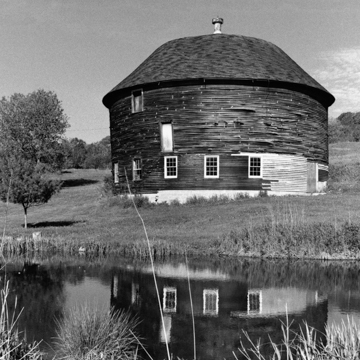Vernon County may boast more round barns than any other county in Wisconsin, and balloon-frame round barns were once more numerous in Wisconsin than anywhere else in the nation, except perhaps Indiana. Franklin H. King, professor of agricultural physics at the Wisconsin Agricultural Experiment Station at Madison, carried out the initial engineering research for round silos and barns, and his “Plan of a Barn for a Dairy Farm,” first published in 1890, was reprinted in books and farm journals throughout the nation. According to King, several factors recommended the round barn. Given its greater volume-to-surface ratio, a circular building required fewer materials to build than other shapes, it offered greater structural stability than a rectangular barn, and its curved walls withstood strong winds better. Moreover, because the walls supported the roof, there was no need for pillars, opening up the space for greater storage capacity. The interior, with a single circular aisle, was supposedly more efficient for dairying, since the farmer could work in a continuous direction, moving from one cow to the next without retracing his steps. King found that wedge-shaped stalls fit cows well and provided ample room for milking. Furthermore, the barn’s central silo allowed for a single, central feeding trough, and it protected the silage from freezing. King’s interest in efficiency reflected a Progressive Era concern that manifested itself not just in agriculture but also in natural resource conservation, city government reform, the management of factory workers, and many other realms.
At last count, eleven round barns still stood in Vernon County. The Lisker Barn (1910; County Road Q, 0.5 miles south of WI 80) was built by Frank Lisker, his sons Joseph and Adolph, and some friends, patterning it on a neighbor’s. Lisker sided his barn with metal, stamped to mimic stone. Inexpensive and durable, stamped zinc was often used to clad rural commercial buildings, but it is unusual for a barn. A conical roof with a round ventilator crowns the structure.
The DeWitt Barn (1912; County Highway Z, 0.6 miles north of County Hwy. ZZ) stands in a picturesque pond-side setting in Cholvin Valley. Typical round barn traits are the horizontal siding, a two-pitch conical roof, and a regular series of windows in the basement. Like most round barns, this one is no longer used. Many farmers found the central silos difficult to fill and the circular fittings expensive to install and maintain. Mechanization and other changes in farm practice made the barns’ claims to efficiency obsolete after World War II.
Here in eastern Vernon County, Alga Shivers, a farmer-carpenter and the son of a progressive farmer, was the leading builder of round barns. He and his family were among the many African Americans who once lived in this area. In the 1850s, the increasing loss of political rights and civil liberties compelled many southern free black families to move north. Six families settled in Cheyenne Valley beginning in 1855. Numerous freed slaves joined them after the Civil War, making Cheyenne Valley probably Wisconsin’s largest rural black community. In 1921 Shivers built a round barn for Joe and Mary Dank, both children of Bohemian immigrants. The Dank Barn (end of Dank Road, 0.6 miles east of County Road F) is sided with vertical boards that likely came from Dank’s woodlot. Shivers typically cured logs for a year or two before cutting them into boards. The windows ringing the barn’s basement provided fresh air and sunshine to the cows. A ramp enabled Dank to drive his wagon or truck directly into the haymow, and the cupola marks the central silo.









